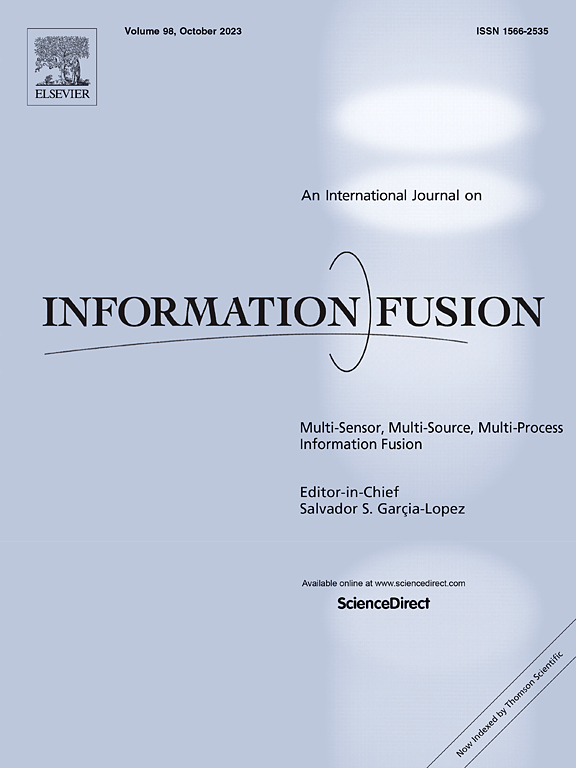MATADOR: Multimodal traffic accident prediction enhanced by multi-source aggregated emotion recognition
IF 15.5
1区 计算机科学
Q1 COMPUTER SCIENCE, ARTIFICIAL INTELLIGENCE
引用次数: 0
Abstract
While predicting traffic accidents is challenging, it is highly valuable as it can greatly improve public safety. Previous studies have mostly relied on time-series data capturing drivers’ physiological responses and behavior along with vehicle movement to predict collisions. However, focusing solely on the driver and target vehicle is insufficient, as driving behavior is also influenced by the external environment, especially in emergencies. In this work, we propose a multi-source aggregation model, termed MATADOR. The model aggregates and fuses data from various sources, including multimodal physiological and behavioral indicators of the driver, sensor data from the target vehicle and its surrounding vehicles, and static environmental data such as weather conditions and potential hazards to predict traffic accidents. MATADOR is built upon multi-source feature extraction, multimodal data fusion, and a novel assisting mechanism to detect driver anger, recognize emotion intensity, and predict traffic accident probability over the following 1, 3, and 5 s, respectively. Thus, MATADOR can provide timely alerts to the driver, helping to prevent potential accidents. This proactive approach sets MATADOR apart from previous studies, highlighting its usefulness in real-world applications. Moreover, recognizing the strong link between drivers’ emotional states and accidents, previous studies have utilized multi-task learning to enhance the accuracy of traffic accident prediction. However, they often treat tasks as isolated branches, failing to capture the dependencies between each other. To tackle this challenge, we developed a dynamic assisting mechanism that allows the model to capture the influence of the emotional states of a driver on accident prediction, thereby realizing task-relevance-driven dynamic optimization. Extensive experiments prove that MATADOR significantly outperforms state-of-the-art methods in traffic accident prediction.
基于多源聚合情感识别的多模式交通事故预测
虽然预测交通事故具有挑战性,但它可以极大地改善公共安全,因此具有很高的价值。以前的研究主要依靠时间序列数据来捕捉驾驶员的生理反应和行为以及车辆的运动来预测碰撞。然而,仅仅关注驾驶员和目标车辆是不够的,因为驾驶行为也受到外部环境的影响,特别是在紧急情况下。在这项工作中,我们提出了一个多源聚合模型,称为MATADOR。该模型汇集和融合了多种来源的数据,包括驾驶员的多模态生理和行为指标、目标车辆及其周围车辆的传感器数据以及天气状况和潜在危险等静态环境数据,以预测交通事故。MATADOR基于多源特征提取、多模态数据融合和一种新的辅助机制来检测驾驶员的愤怒情绪,识别情绪强度,并预测接下来1、3和5秒的交通事故概率。因此,MATADOR可以向驾驶员提供及时的警报,帮助防止潜在的事故。这种主动的方法使MATADOR与以前的研究不同,突出了它在实际应用中的实用性。此外,由于认识到驾驶员情绪状态与交通事故之间的密切联系,已有研究利用多任务学习来提高交通事故预测的准确性。然而,它们经常将任务视为孤立的分支,无法捕获彼此之间的依赖关系。为了应对这一挑战,我们开发了一种动态辅助机制,使模型能够捕捉驾驶员情绪状态对事故预测的影响,从而实现任务相关性驱动的动态优化。大量的实验证明,MATADOR在交通事故预测方面明显优于最先进的方法。
本文章由计算机程序翻译,如有差异,请以英文原文为准。
求助全文
约1分钟内获得全文
求助全文
来源期刊

Information Fusion
工程技术-计算机:理论方法
CiteScore
33.20
自引率
4.30%
发文量
161
审稿时长
7.9 months
期刊介绍:
Information Fusion serves as a central platform for showcasing advancements in multi-sensor, multi-source, multi-process information fusion, fostering collaboration among diverse disciplines driving its progress. It is the leading outlet for sharing research and development in this field, focusing on architectures, algorithms, and applications. Papers dealing with fundamental theoretical analyses as well as those demonstrating their application to real-world problems will be welcome.
 求助内容:
求助内容: 应助结果提醒方式:
应助结果提醒方式:


